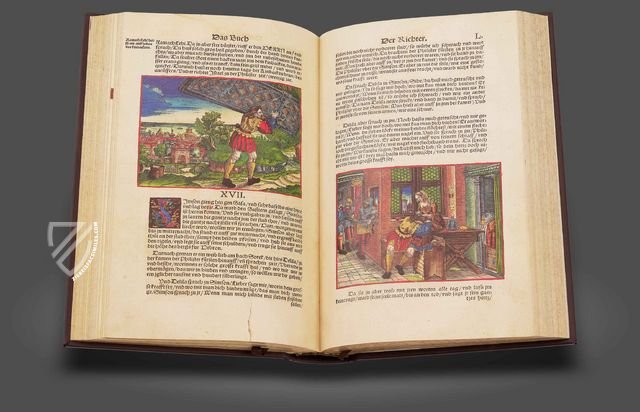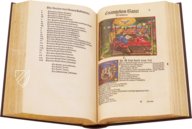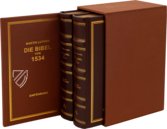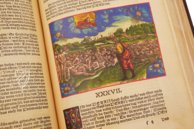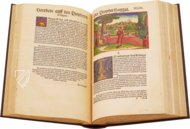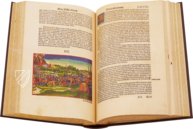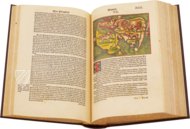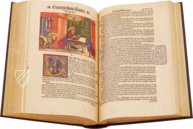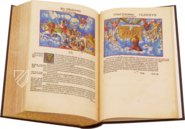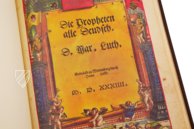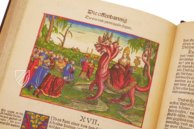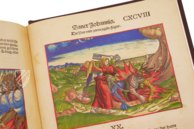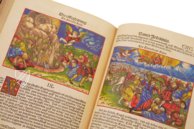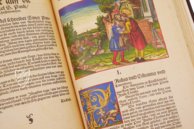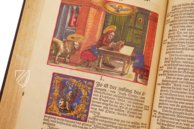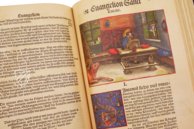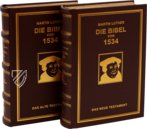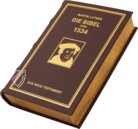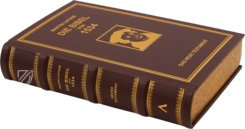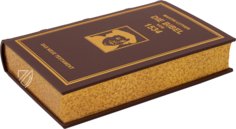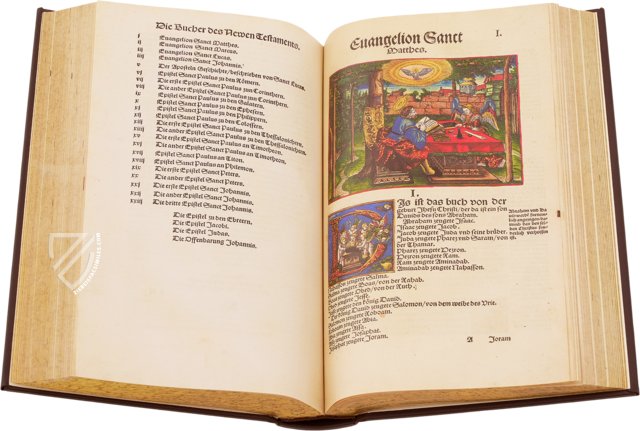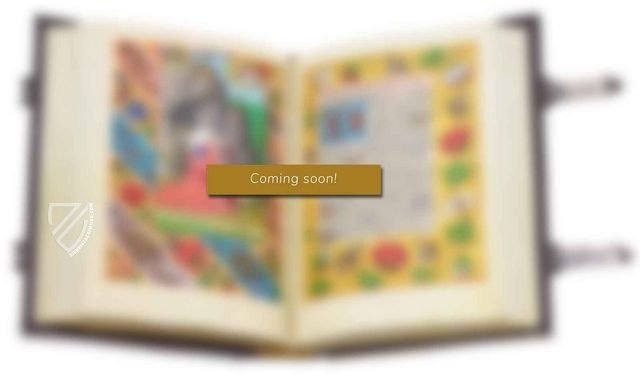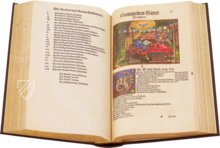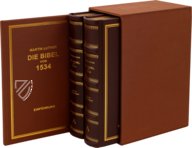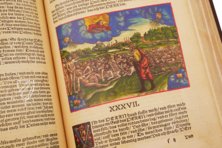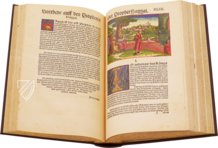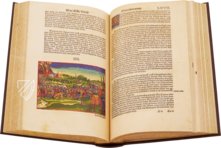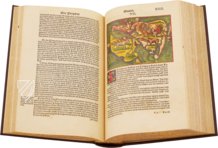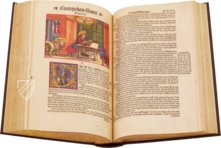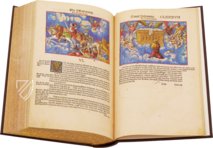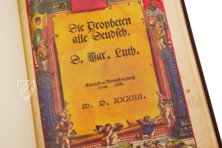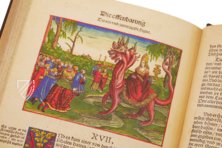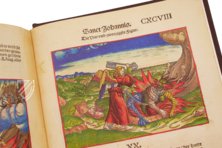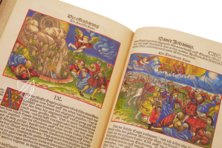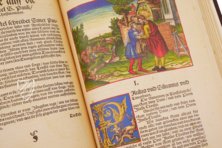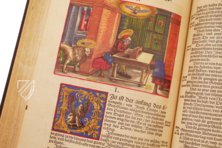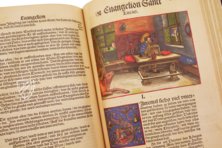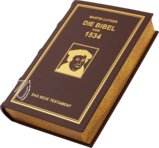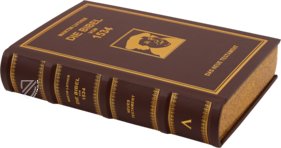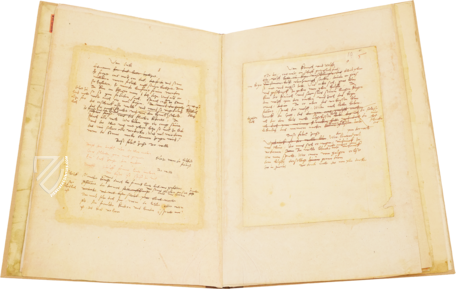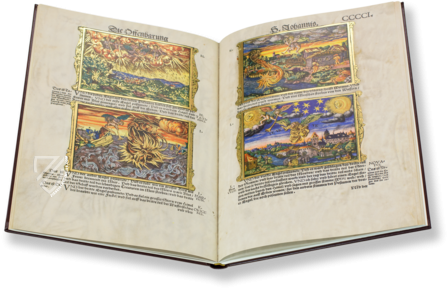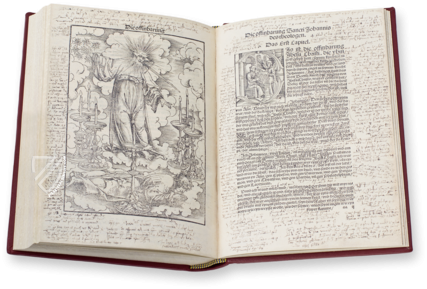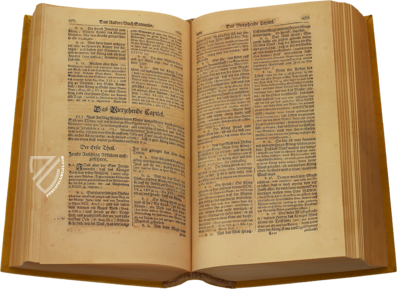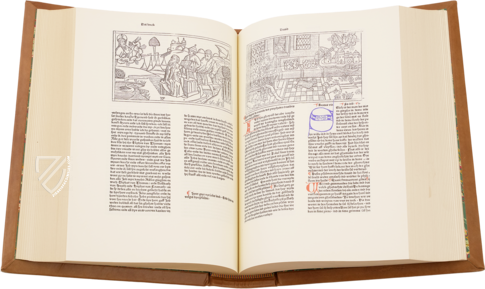Martin Luther - The 1534 Bible
(under 1,000€)
Although by no means the first translation of the Bible into German, Martin Luther drew from Latin, Greek, and Hebrew sources in order to create a translation in the language of the modern people. He did this by spending time in nearby towns and markets listening to people speak with one another. Combined with the recent invention of the printing press, the Luther Bible made waves across Europe and inspired other theologians to make vernacular translations of their own. The result was a model for the development of New High German. This cultural treasure from the Duchess Anna Amalia Library in Weimar, the highlight of its prestigious collections, is the most precious and artful of the 60 surviving copies of the first complete edition of the Luther Bible, which was published in 1534. What sets it apart is the quality of its 128 woodcuts, which have been painted with deep shades of blue, green, and red as well as being occasionally illuminated with gold. 28 of the woodcuts originated from the workshop of Lucas Cranach the Elder and some of those decorated with gold are even said to have been made by Cranach himself. Thankfully, this gem was saved from destruction when the library caught fire and remains undamaged today.
Luther Bible of 1534
Few historical figures have had as far-reaching of an impact as Martin Luther (1483–1546). The most important figure of the Protestant Reformation is one of the most important figures in the history of Germany and the German language because of his translation of the Bible so that it could be understood by the laity. After the New Testament was first published in 1522, a complete edition containing the Old and New Testaments with Apocrypha followed in 1534. Of the 60 surviving copies of the first complete edition, the specimen housed in the Duchess Anna Amalia Library in Weimar is unquestionably the finest. Its 128 woodcuts have been richly colored with blue, red, and green; some have even illuminated with gold. The splendid print must have been commissioned by a wealthy patron, but none has been identified and nothing is known about its ownership history before it was acquired by the library in 1815.
Luther’s Historic Translation
Luther was not the first to translate the Bible into German but what distinguishes his translation is that it did not use the Latin Vulgate as a source but drew from the original Hebrew and Greek. He also spent time in various towns and markets listening to the language of the common people to ensure that they, his target audience, would be able to comprehend his translation. His German language Bible inspired other theologians across Europe to create their own vernacular translations, but also doomed the continent to generations of religious warfare. Nonetheless, Luther’s translation is considered by many to be his greatest work with far-reaching religious, linguistic, and cultural significance.
A Luxury Print
The Luther Bible would never have had the influence it did without the recent invention of the printing press and about 200,000 copies were printed during Luther’s lifetime. However, the era of cheap printed books was a long way off and even an unbound copy of the complete Bible cost a month’s wages for the average laborer. As such, the common man only encountered the Luther Bible second hand through churches, pastors, and schools. The first complete edition from 1534 was printed by Hans Lufft (1495–1584) in Wittenberg, who also produced this special unicum and would print 100,000 copies of the Bible altogether. Aside from a title page for the Old Testament depicting Joshua created by Lucas Cranach the Elder (ca. 1472–1553), a close friend of Luther’s, the rest of the 128 engravings originated from the so-called Master MS. 62 of are illustrations measuring 10.8 x 14.7 cm, 41 illustrations for the Old Testament and 21 for the New Testament, while the rest consist of decorative and historiated initials. Luther is reported to have personally participated in the design of the woodcuts.
Codicology
- Alternative Titles
- Luther Bibel von 1534
Biblia, das ist, Die gantze Heilige Schrifft deudsch
Bible de Luther de 1534
Martin Luther - Die Bibel von 1534 - Size / Format
- 1674 pages / 31.5 × 21.0 cm
- Origin
- Germany
- Date
- 1534
- Epochs
- Style
- Genre
- Language
- Illustrations
- 128 large, colorful, partly full-page woodcuts and numerous imaginative initials
- Artist / School
- Martin Luther (author)
Martin Luther’s 1534 Bible
The Imprisonment of Jeremiah
After prophesying that Jerusalem would fall to the Babylonians, the already unpopular Jeremiah is cast into a cistern and left to die. Ebed-Melech the Ethiopian, one of King Zedekiah’s eunuchs, makes an appeal on the prophet’s behalf and changes the King’s mind, who orders Ebed-Melech to take 30 men and some rope to retrieve Jeremiah, but it does not save Jerusalem from destruction. Today, “Jeremiad” is used to describe a work prophesying the downfall of a society because of some moral failure.
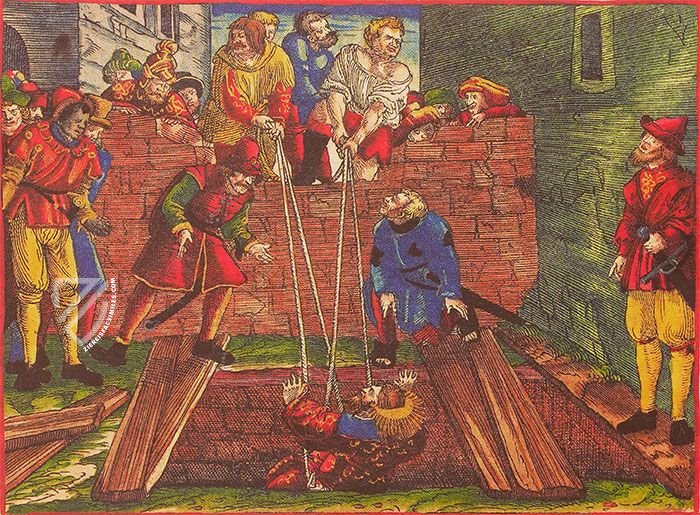
Martin Luther’s 1534 Bible
The Second and Third Trumpets
In the upper register, sailors in carracks, some seemingly shaking their fists at the second angel, reel from the impact of a massive meteor. It is described as “something like a great mountain burning with fire”, which turns a third of the sea to blood (depicted on the left), kills a third of the sea creatures, and destroys a third of the ships. (Rev. 8:8–9).
Below, similar events occur on land as the bodies of richly dressed villagers litter the ground. “Then the third angel sounded: And a great star fell from heaven, burning like a torch, and it fell on a third of the rivers and on the springs of water. The name of the star is Wormwood. A third of the waters became wormwood, and many men died from the water, because it was made bitter.” (Rev. 8:10–11)
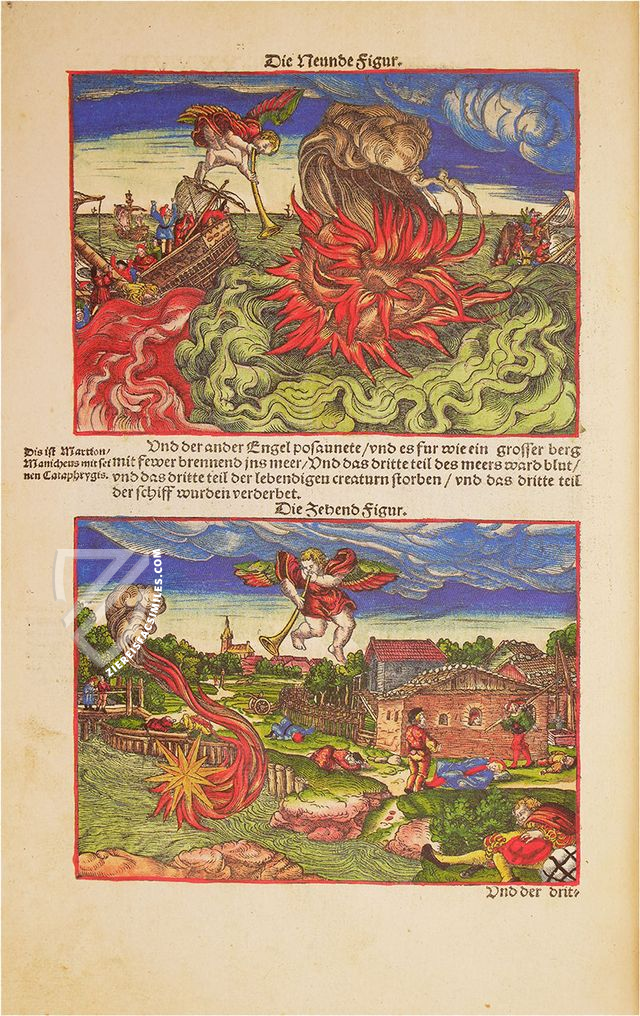
#1 Biblia, das ist, die gantze Heilige Schrifft Deudsch
Language: German
(under 1,000€)
#2 Die Luther-Bibel von 1534
(under 1,000€)
- Treatises / Secular Books
- Apocalypses / Beatus
- Astronomy / Astrology
- Bestiaries
- Bibles / Gospels
- Chronicles / History / Law
- Geography / Maps
- Saints' Lives
- Islam / Oriental
- Judaism / Hebrew
- Single Leaf Collections
- Leonardo da Vinci
- Literature / Poetry
- Liturgical Manuscripts
- Medicine / Botany / Alchemy
- Music
- Mythology / Prophecies
- Psalters
- Other Religious Books
- Games / Hunting
- Private Devotion Books
- Other Genres
- Afghanistan
- Armenia
- Austria
- Belgium
- Belize
- Bosnia and Herzegovina
- China
- Colombia
- Costa Rica
- Croatia
- Cyprus
- Czech Republic
- Denmark
- Egypt
- El Salvador
- Ethiopia
- France
- Germany
- Greece
- Guatemala
- Honduras
- Hungary
- India
- Iran
- Iraq
- Israel
- Italy
- Japan
- Jordan
- Kazakhstan
- Kyrgyzstan
- Lebanon
- Liechtenstein
- Luxembourg
- Mexico
- Morocco
- Netherlands
- Palestine
- Panama
- Peru
- Poland
- Portugal
- Romania
- Russia
- Serbia
- Spain
- Sri Lanka
- Sweden
- Switzerland
- Syria
- Tajikistan
- Turkey
- Turkmenistan
- Ukraine
- United Kingdom
- United States
- Uzbekistan
- Vatican City
- A. Oosthoek, van Holkema & Warendorf
- Aboca Museum
- Ajuntament de Valencia
- Akademie Verlag
- Akademische Druck- u. Verlagsanstalt (ADEVA)
- Aldo Ausilio Editore - Bottega d’Erasmo
- Alecto Historical Editions
- Alkuin Verlag
- Almqvist & Wiksell
- Amilcare Pizzi
- Andreas & Andreas Verlagsbuchhandlung
- Archa 90
- Archiv Verlag
- Archivi Edizioni
- Arnold Verlag
- ARS
- Ars Magna
- ArtCodex
- AyN Ediciones
- Azimuth Editions
- Badenia Verlag
- Bärenreiter-Verlag
- Belser Verlag
- Belser Verlag / WK Wertkontor
- Benziger Verlag
- Bernardinum Wydawnictwo
- BiblioGemma
- Biblioteca Apostolica Vaticana (Vaticanstadt, Vaticanstadt)
- Bibliotheca Palatina Faksimile Verlag
- Bibliotheca Rara
- Boydell & Brewer
- Bramante Edizioni
- Bredius Genootschap
- Brepols Publishers
- British Library
- C. Weckesser
- Caixa Catalunya
- Canesi
- CAPSA, Ars Scriptoria
- Caratzas Brothers, Publishers
- Carus Verlag
- Casamassima Libri
- Centrum Cartographie Verlag GmbH
- Chavane Verlag
- Christian Brandstätter Verlag
- Circulo Cientifico
- Club Bibliófilo Versol
- Club du Livre
- CM Editores
- Collegium Graphicum
- Collezione Apocrifa Da Vinci
- Comissão Nacional para as Comemorações dos Descobrimentos Portugueses
- Coron Verlag
- Corvina
- CTHS
- D. S. Brewer
- Damon
- De Agostini/UTET
- De Nederlandsche Boekhandel
- De Schutter
- Deuschle & Stemmle
- Deutscher Verlag für Kunstwissenschaft
- DIAMM
- Droz
- E. Schreiber Graphische Kunstanstalten
- Ediciones Boreal
- Ediciones Grial
- Ediclube
- Edições Inapa
- Edilan
- Editalia
- Edition Deuschle
- Edition Georg Popp
- Edition Leipzig
- Edition Libri Illustri
- Editiones Reales Sitios S. L.
- Éditions de l'Oiseau Lyre
- Editions Medicina Rara
- Editorial Casariego
- Editorial Mintzoa
- Editrice Antenore
- Editrice Velar
- Edizioni Edison
- Egeria, S.L.
- Eikon Editores
- Electa
- Emery Walker Limited
- Enciclopèdia Catalana
- Eos-Verlag
- Ephesus Publishing
- Ernst Battenberg
- Eugrammia Press
- Extraordinary Editions
- Fackelverlag
- Facsimila Art & Edition
- Facsimile Editions Ltd.
- Facsimilia Art & Edition Ebert KG
- Faksimile Verlag
- Feuermann Verlag
- Folger Shakespeare Library
- Franco Cosimo Panini Editore
- Friedrich Wittig Verlag
- Fundación Hullera Vasco-Leonesa
- G. Braziller
- Gabriele Mazzotta Editore
- Gebr. Mann Verlag
- Gesellschaft für graphische Industrie
- Getty Research Institute
- Giovanni Domenico de Rossi
- Giunti Editore
- Graffiti
- Grafica European Center of Fine Arts
- Guido Pressler
- Guillermo Blazquez
- Gustav Kiepenheuer
- H. N. Abrams
- Harrassowitz
- Harvard University Press
- Helikon
- Hendrickson Publishers
- Henning Oppermann
- Herder Verlag
- Hes & De Graaf Publishers
- Hoepli
- Holbein-Verlag
- Houghton Library
- Hugo Schmidt Verlag
- Idion Verlag
- Il Bulino, edizioni d'arte
- ILte
- Imago
- Insel Verlag
- Insel-Verlag Anton Kippenberger
- Instituto de Estudios Altoaragoneses
- Instituto Nacional de Antropología e Historia
- Introligatornia Budnik Jerzy
- Istituto dell'Enciclopedia Italiana - Treccani
- Istituto Ellenico di Studi Bizantini e Postbizantini
- Istituto Geografico De Agostini
- Istituto Poligrafico e Zecca dello Stato
- Italarte Art Establishments
- Jan Thorbecke Verlag
- Johnson Reprint Corporation
- Josef Stocker
- Josef Stocker-Schmid
- Jugoslavija
- Karl W. Hiersemann
- Kasper Straube
- Kaydeda Ediciones
- Kindler Verlag / Coron Verlag
- Kodansha International Ltd.
- Konrad Kölbl Verlag
- Kurt Wolff Verlag
- La Liberia dello Stato
- La Linea Editrice
- La Meta Editore
- Lambert Schneider
- Landeskreditbank Baden-Württemberg
- Leo S. Olschki
- Les Incunables
- Liber Artis
- Library of Congress
- Libreria Musicale Italiana
- Lichtdruck
- Lito Immagine Editore
- Lumen Artis
- Lund Humphries
- M. Moleiro Editor
- Maison des Sciences de l'homme et de la société de Poitiers
- Manuscriptum
- Martinus Nijhoff
- Maruzen-Yushodo Co. Ltd.
- MASA
- Massada Publishers
- McGraw-Hill
- Metropolitan Museum of Art
- Militos
- Millennium Liber
- Müller & Schindler
- Nahar - Stavit
- Nahar and Steimatzky
- National Library of Wales
- Neri Pozza
- Nova Charta
- Oceanum Verlag
- Odeon
- Orbis Mediaevalis
- Orbis Pictus
- Österreichische Staatsdruckerei
- Oxford University Press
- Pageant Books
- Parzellers Buchverlag
- Patrimonio Ediciones
- Pattloch Verlag
- PIAF
- Pieper Verlag
- Plon-Nourrit et cie
- Poligrafiche Bolis
- Presses Universitaires de Strasbourg
- Prestel Verlag
- Princeton University Press
- Prisma Verlag
- Priuli & Verlucca, editori
- Pro Sport Verlag
- Propyläen Verlag
- Pytheas Books
- Quaternio Verlag Luzern
- Reales Sitios
- Recht-Verlag
- Reichert Verlag
- Reichsdruckerei
- Reprint Verlag
- Riehn & Reusch
- Roberto Vattori Editore
- Rosenkilde and Bagger
- Roxburghe Club
- Salerno Editrice
- Saltellus Press
- Sandoz
- Sarajevo Svjetlost
- Schöck ArtPrint Kft.
- Schulsinger Brothers
- Scolar Press
- Scrinium
- Scripta Maneant
- Scriptorium
- Shazar
- Siloé, arte y bibliofilia
- SISMEL - Edizioni del Galluzzo
- Sociedad Mexicana de Antropología
- Société des Bibliophiles & Iconophiles de Belgique
- Soncin Publishing
- Sorli Ediciones
- Stainer and Bell
- Studer
- Styria Verlag
- Sumptibus Pragopress
- Szegedi Tudomànyegyetem
- Taberna Libraria
- Tarshish Books
- Taschen
- Tempus Libri
- Testimonio Compañía Editorial
- Thames and Hudson
- The Clear Vue Publishing Partnership Limited
- The Facsimile Codex
- The Folio Society
- The Marquess of Normanby
- The Richard III and Yorkist History Trust
- Tip.Le.Co
- TouchArt
- TREC Publishing House
- TRI Publishing Co.
- Trident Editore
- Tuliba Collection
- Typis Regiae Officinae Polygraphicae
- Union Verlag Berlin
- Universidad de Granada
- University of California Press
- University of Chicago Press
- Urs Graf
- Vallecchi
- Van Wijnen
- VCH, Acta Humaniora
- VDI Verlag
- VEB Deutscher Verlag für Musik
- Verlag Anton Pustet / Andreas Verlag
- Verlag Bibliophile Drucke Josef Stocker
- Verlag der Münchner Drucke
- Verlag für Regionalgeschichte
- Verlag Styria
- Vicent Garcia Editores
- W. Turnowski Ltd.
- W. Turnowsky
- Waanders Printers
- Wiener Mechitharisten-Congregation (Wien, Österreich)
- Wissenschaftliche Buchgesellschaft
- Wissenschaftliche Verlagsgesellschaft
- Wydawnictwo Dolnoslaskie
- Xuntanza Editorial
- Zakład Narodowy
- Zollikofer AG

